THIS CONTENT IS BROUGHT TO YOU BY SINTEF - read more
Smart heating: There is hope for older office buildings
Researchers managed to cut energy consumption by a third without expensive upgrades.

The reduction in energy consumption has been demonstrated through a collaboration between researchers from SINTEF and the technical contractor GK.
The system is based on multiple factors, including future electricity prices and weather data.
“The results of the heating system upgrades look promising. The investment costs are minimal and have potential for a lot of savings. Similar control systems are widely used in industrial processes, but the untapped potential in buildings is still huge,” says Harald Taxt Walnum, a research scientist at SINTEF.
Electricity prices and weather forecasts
In the experiment, the researchers used Model Predictive Control (MPC) techniques in one of SINTEF's office buildings from the 1960s.
MPC is used in everything from self-driving cars to chemical plants and drones. It is one of the best methods for controlling systems that require precision and efficiency.
Such a system controls by predicting what will happen in the future. Everything is adjusted along the way to achieve the best possible result.
The 60-year-old radiator control system, which only regulated heat based on the outdoor temperature, was upgraded with MPC.
The result: Over the course of one and a half months, energy consumption was reduced by 33 per cent compared to expected consumption during normal operation.
“What distinguishes MPC from more traditional control methods is the ability to be forward thinking. Instead of just reacting to changes as they occur, MPC plans how the system will behave to achieve the best possible results over time,” says Walnum.
The system analyses multiple variables, including future electricity prices and weather forecasts, to use as little electricity as possible when prices are high.
The system also received precise data on temperature and energy use in the building. This made it possible to optimise heat adjustments. It saved both energy and costs, and the indoor climate in the building improved.
“The effect wouldn't necessarily have been as great if the study had been conducted at a different time of year, when fluctuations in temperature and electricity prices are smaller,” says Peder Ward, a civil engineer in cybernetics at GK.
During the test period in April and May, there were several days when the temperature in the shade was relatively low, while the heat from the sun gave a completely different actual outdoor temperature.
Great savings potential in old buildings
Many commercial buildings in Norway and Europe have old radiators.
Upgrading to modern zone control with new thermostats and sensors in each room is expensive.
The MPC system uses existing infrastructure in the buildings, at a fraction of the cost.
Ward therefore believes that this model could be an important contribution to the collective societal effort to improve energy efficiency.
“We know that buildings account for around 30 per cent of the world’s total energy consumption and almost as much of the energy-related CO₂ emissions. In addition, most buildings that will still be in use in 2050 have already been built. If we expect to succeed in green transition, we have to look at how we can utilise existing buildings and technology more efficiently,” he says.
Ward also believes that solutions like MPC give buildings the flexibility to adapt to future needs.
“The technology can be connected to smart networks where buildings help relieve the power grid by reducing consumption during periods of high energy load. This can also help support the use of renewable energy," he explains.
Some challenges remain
Scaling up the solution will require further development.
One of the challenges in the project was to ensure stable data connections and to be able to handle periods of missing measurement data.
“The model handled this surprisingly well, but a backup solution is needed that can ensure continuous operation if data access or the MPC system becomes unstable,” says Ward.
Walnum is working on a PhD on the MPC system. He is looking more closely at how the system performs over time and how the model can work in buildings with more modern technology.
“We need to create a better 'plug and play' solution that doesn’t require major local adaptations,” he says.
Energy-efficient collaboration
Ward and Walnum are nevertheless very satisfied with the results of the project. Their collaboration has resulted in a scientific article and real-world implementation of the new knowledge.
“This experiment is a good example of what we can achieve when research institutes and industry collaborate,” says Ward.
The study was conducted as part of the Research Centre on Zero Emission Neighbourhoods (FME ZEN).
Reference:
Walnum et al. Demonstration of a low-cost solution for implementing MPC in commercial buildings with legacy equipment, Applied Energy, vol. 380, 2025. DOI: 10.1016/j.apenergy.2024.125012
More content from SINTEF:
-
How Svalbard is becoming a living lab for marine restoration
-
New study: Even brand-new apartments in cities can have poor indoor air quality
-
Fresh hope for patients with chronic inflammatory bowel disease
-
Testing a giant ship: May take five kilometres to stop
-
A robot is helping researchers hunt for the best cancer warriors
-
Locomotives that run on diesel can be electrified





































